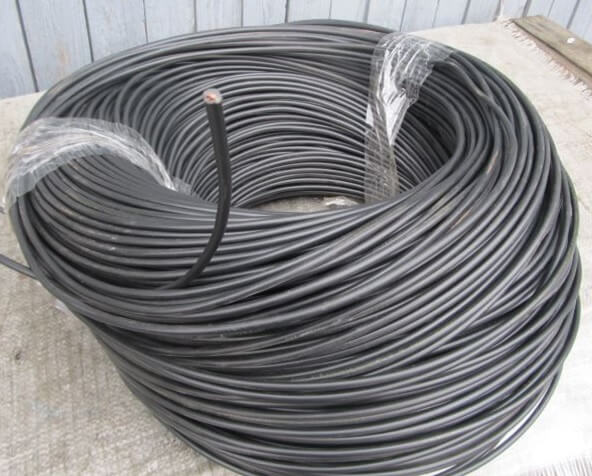Runway Submersible Wire Characteristics
Labeling Explanation
Marking of any domestic cable contains quite interesting information about what it is made of. The abbreviation for the runway abbreviation contains the following information:
- B - “water submersible wire”, i.e. it is intended for long-term work at great depths under high pressure, we will describe these characteristics in detail below;
- P - core insulation consists of high pressure polyethylene (LDPE);
- P - shell (external insulation) made of polyethylene (LDPE).
Design Features
The core of the runway wire is made of copper, multi-wire, which gives it good flexibility, in contrast to monolithic (single-wire) wires. Often in the products of other brands you can find two options with the addition of the letter “A” in the name and without it - this suggests that there was an aluminum core. In the case of the runway, the core design is copper only. What is characteristic, the maximum number of cores for this conductor is one. This must be taken into account when calculating the electrical installation, multiplying the length of the line by the number of poles in it.
Runway wire is made according to GOST 6323-78 or TU U31.3-20006134-030-2004. The vein is made according to GOST 22483-77.
Specifications
The runway brand is designed for use in electrical networks and installations with a maximum voltage of up to 1000 V. In AC circuits with a frequency of 50 Hz. When working with rated voltage, high-quality and reliable insulation is guaranteed, if it is mounted in a circuit with a high voltage, damage to the insulation is possible.
Since the wire is submersible, it must withstand high pressure. The design and materials of which the runway is made can withstand up to 6.86 * 106 Pa
The runway wire belongs to the II class of flexibility, but this does not allow it to hang swinging objects. It is necessary to carry out a fixed installation in order to eliminate unnecessary load on the cores. The ambient temperature during installation should be higher than -15 ° C. In severe frosts, the insulation of most cables is dubbed, there is a likelihood of damage during bending and difficulty in removing it. Operational temperature range from -40 ° to + 80 ° C.
Manufacturers give a guarantee for 2.5 years, and the recommended service life is 6 years. It should be borne in mind that the higher the temperature in which the wire is installed, the lower the average resource of work:
- at + 50 ° С - 32,000 hours;
- at + 65 ° С - 20 000 hours;
- at + 80 ° С - 16 000 hours.
The main characteristic that describes the suitability of the conductor is the insulation resistance. In this case, at the time of acceptance of the wire and its installation should be:
- at a voltage of 380 V - 1000 MΩ;
- at a voltage of 660 V - 2500 MΩ.
To correctly carry out the measurement, the temperature should be on the order of + 20 ° С, before the wire is lowered into water for 3 hours.
The size range of the runway wire is quite extensive, manufacturers produce products with a cross-sectional area of the core from 1.2 mm2 up to 70 mm2. In this case, the cross-sectional area, i.e. runway 4 wire will have 4 mm2 in cross section.
All runway wire cross-sections are provided in the table:

Cross sections of 95 and 120 mm are also found.2but they are less common.
Scope and purpose
Let's look at what the runway is used for. It is designed to power devices that are located in water. An example of such installations are submersible pumps in wells. It is worth noting that not every pump, or rather its electric motor, is designed to work under water. Enclosures must be made in accordance with the standards for such working conditions. By the way, the pressure that the wire can withstand allows it to be used not only in wells, but also in artesian wells, which have a depth of more than 30 m. It can also be used in mines for pumping water from flooded sections of lava. In addition, among possible applications, laying under water can be distinguished, for example, at the bottom of reservoirs, pools and drains.
We have already said that the purpose of the runway is the installation of electrical installations at a depth. If the pump connected to it is very deep, it is necessary to foresee the fastening of the wire, because its weight will also be large, more specifically, you saw it in the table above.
Manufacturers and analogues
In electrical goods stores, products from the following manufacturers are presented:
- JSC Belaruskabel
- JSC Cable Factory Kavkazkabel
- JSC OKB KP
- JSC "Schuchinsky Plant" Avtoprovod "
- OJSC NP Podolskkabel
- LLC "Rybinskkabel"
- LLC Tomskkabel
- JSC Uralkabel, LLC KhKA
- OJSC "Electrocable" Kolchuginsky Plant ", LLC" KhKA "
- LLC Energokomplekt MF
In addition to this conductor, there are other varieties that are resistant to water. The domestic analogue can be called ERW, it differs in that it is less resistant to salt water, but more resistant to light, its outer shell is made of PVC. Another option that can be used in water is KVV, with two layers of polyvinyl chloride insulation. It is suitable for both stationary and mobile installation.
The runway wire under consideration is capable of operating in harsh conditions. Humidity and water are a big problem for electricians and the safety of maintenance workers. We hope the provided description of the characteristics, as well as the scope of the conductor, were useful to you!
It will be useful to read:








